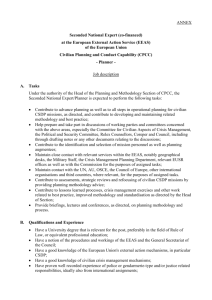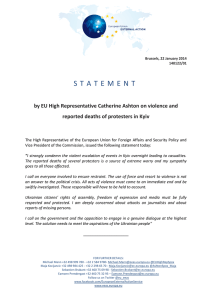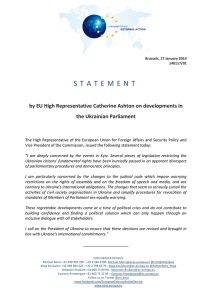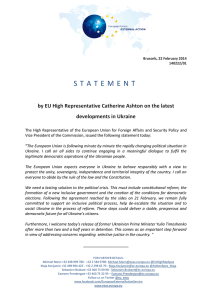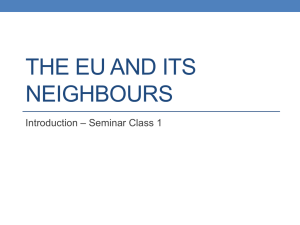POLICY EUROPEAN
advertisement
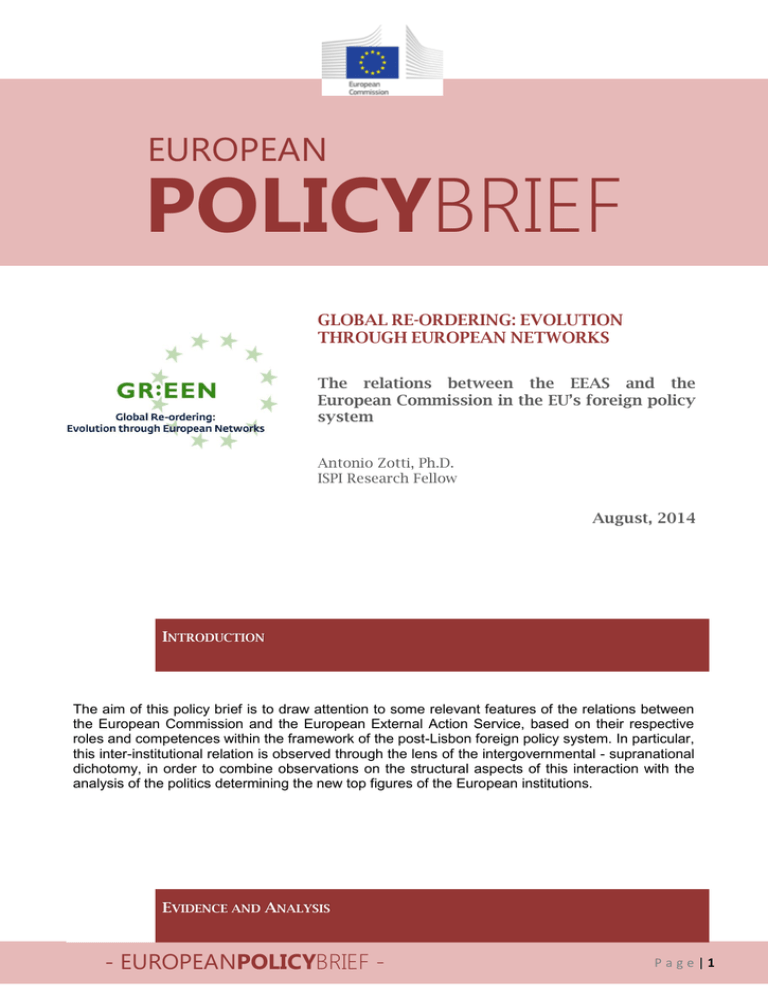
EUROPEAN POLICYBRIEF GLOBAL RE-ORDERING: EVOLUTION THROUGH EUROPEAN NETWORKS The relations between the EEAS and the European Commission in the EU’s foreign policy system Antonio Zotti, Ph.D. ISPI Research Fellow August, 2014 INTRODUCTION The aim of this policy brief is to draw attention to some relevant features of the relations between the European Commission and the European External Action Service, based on their respective roles and competences within the framework of the post-Lisbon foreign policy system. In particular, this inter-institutional relation is observed through the lens of the intergovernmental - supranational dichotomy, in order to combine observations on the structural aspects of this interaction with the analysis of the politics determining the new top figures of the European institutions. EVIDENCE AND ANALYSIS - EUROPEANPOLICYBRIEF - Page|1 Why the EEAS and the Commission The relations between the European External Action Service (EEAS) and the European Commission can be regarded as representative of the ambiguousness and the latent capabilities of the EU foreign policy system as a whole. While the Commission can be associated with the notion of a transnational bureaucratic/technocratic body, the EEAS appears as a self-contained attempt to keep together the intergovernmental and the supranational aspects of the Union’s foreign policy. 1 Accordingly, the relations between the two bodies reflect the tensions between the different methods and political rationales underlying the whole European political system. From a more practical perspective, the connection with the Commission is acknowledged as “vital” to the operation of the Service, and it is the lack of a more efficient coordination that prevents the full development of the Union’s comprehensive approach.2 Intergovernmental and supranational dimensions of the EU external action Foreign policy is the domain where the dichotomy between the intergovernmentalism and supranationalism has been more clearly institutionalized within the broader EU policy system. This polarity is employed here with full awareness of its crudeness and implicit normative connotation – common to all scientific terminology3, and is aimed at pointing out the endurance of a surreptitious pillar system that defies the intent of the Treaty to suppress the ‘intrinsic dualism of the EU’s external action’.4 The creation of two sets of specific institutional arrangements and procedures to be applied respectively to the Common Foreign and Security Policy (CFSP) and the other external policies impacts on the ‘supranational-intergovernmental setup of the Union’.5 The policies traditionally under the domain of the Commission – such as enlargement, development, common commercial policy, or neighbourhood policies – are governed according to the “community method” logic. This is characterized by the Commission’s monopoly of the right of initiative, qualified majority voting in the Council, the European Parliament as co-legislator and the Court of Justice ensuring uniform interpretation of Community law. Conversely, in the intergovernmental method, Member States usually decide by unanimity and the Commission shares the right of initiative. Despite the dismissal of the pillar system, the Lisbon Treaty did not dissolve the tension between a logic based on depoliticized policy input from the Commission (supported by impact assessment and politicized negotiations among co-legislators) and the unanimity voting and hierarchical control by national governments.6 While reforms like the transformation of the former “co-decision procedure” into the ordinary legislative procedure did contribute to expanding the community method rationale making the whole system generally more consistent, the foreign policy area remained subject to this persistent tension, which seems to created more complicated relations between the Commission and the newly created EEAS. The post-Lisbon inter-institutional balance of power The reform introduced by the Lisbon Treaty together with the Eurozone crisis had dramatic effects in terms of reallocation of power among EU institutions. In general, the European Council and its President seem to have gained a dominant position over the rest of the system – due to the prominence of financial and economic issues among the European priorities, but also to Van Rompuy’s ability to present himself to national governments as a reassuring moderator rather than the promoter of a distinct policy agenda.7 As for the external dimension, the European Council is given a wide-ranging strategic leadership role, based on its faculty to identify the strategic interests and objectives of the Union. Consequently, the Council is the ultimate controller of the CFSP/CSDP, retaining the authority to define the guidelines that steer the coordination and implementation duties and capabilities assigned to the HR – with the transfer of the chairmanship 1 A.A. Ellinas, E. Suleiman, The European Commission and Bureaucratic Autonomy, NY, Cambridge University Press, 2012. 2013 EEAS Review, p. 7. Rosamond (2000), p. 49 4 C. Cellerino (2011) ‘The New European External Action Service And The Lisbon Call For Coherence Of European External Action: Issues Of Accountability And Scope’, Columbia Journal of European law, 17, 22 5 F. Laursen (2012), The EU's Lisbon Treaty. Institutional Choices and Implementation, Ashgate, p. 22 6 Ibid. p. 23 7 D. Schwarzer (2012), ‘The Euro Area Crisis: Shifting Power Relations and Institutional Change in the European Union?’, Global Policy, 1(3): 28-41 2 3 - EUROPEANPOLICYBRIEF - Page|2 of the Foreign Affair Council to the HR affecting the rotating presidency system and the FAC formation. As to the Commission’s post-Lisbon standing, the effect of the on-going “creeping” institutional change varies across policy areas. Though affected by the long-term decrease in institutional authority experienced since the Santander College, which arose from the increasing use of decision-making procedures other than the Community method and the long-lasting growing institutional importance of the European Council and the European Parliament, the Commission has not suffered heavy losses in the inter-institutional “balance of power”. Instead it has been called to further adjust to a less dominant but no less necessary position within the institutional setting. As far as economic governance is concerned, the concentration of the strategic direction and agenda-setting powers in the hands of the European Council and the Euro Summit has been compensated by the expansion of the Commission’s operational role. This is derived from the competences assigned by the Six Pack in budgetary and economic policy coordination, the European Semester as well as its belonging to the Troika. Within the field of foreign policy, the post-Lisbon position of the Commission reflects an even lesser degree of “zero-sum” logic, with the consistent transfer of competences to the HR and the EEAS that in fact has not appear to drastically affect its functioning. The strengthened institutional position of the European Council, together with the establishment of the semi-permanent post of European Council President, creates a subject endowed with remarkable capabilities in the foreign policy-making process. The extent of these capabilities are still to be determined, as until now the centre of attention of the European Council has been to focus upon a response to the sovereign debt crisis, which has prevented the President from exerting the powers bestowed on him by the Treaty (art 15:6 TUE). Similarly, the creation of the office of HR also happens to the Commission’s (potential) chagrin, since this post – unlike the previous HR incarnations – incorporates the former Commissioner for External Relations. Furthermore, the “double-hatted” nature of the post – serving as the Council’s HR and a Commission’s Vice President – might give rise to conflicts about its institutional loyalty. Finally, the establishment of the EEAS – in addition to taking over specific competences like the control of the Union’s Representations – sets the stage for potentially aggressive inter-institutional struggles about how the service should actually be structured and under whose authority each issue should be dealt with. These basic queries are of great consequence for the Commission because while the relation of the EEAS with the European Council is more clearly recognizable as being of a hierarchical nature, depending on the interpretation of the Treaty provisions and the practices that will emerge, it may well evolve into a mere service or an institutional competitor. Yet, even though all these factors have contributed to undermining its position in the external relations policy, the Commission keeps hold of a considerable share of institutional power – making ever more relevant the issue of its cooperation with the EEAS. This resilience can be accounted for by the important portfolios the Commission retains like trade, development, cooperation, neighbourhood policy and enlargement. Indeed, enlargement is a particularly significant responsibility, as the management of the complex accession processes that led to the 2004-2007 enlargement was a major route of the flow of new tasks and powers towards the Commission. The relatively clear separation between the Council/HR-led CFSP/CSDP and the other external action competences has also helped the Commission protect and assert its prerogatives. Reportedly, the Commission not only negotiated the independence of its external action, but also deliberately undermined the HR’s coordinating role of the so-called RELEX group – the External Relations Group of Commissioners including the President, the Trade Commissioner, the Enlargement Commissioner, the Commissioner for Development policy, the Commissioner for Humanitarian Assistance and the Commissioner for Economic and Monetary Affairs. If the Commission was less able to drive the EU’s overall external relations agenda it would still retain its role specific policy goal setting. However this is rather marginal as far as the CFSP is concerned and unless the Council deliberately rescinds power the commission has few possibilities to grow through the expansion of the HR/VP’s responsibilities. Moreover, when it comes to enlargement and neighbourhood policy, trade, development and issues related to the external dimension of internal policies, the Commission retains its prominent - EUROPEANPOLICYBRIEF - Page|3 role in coordinating initiatives, managing elaborated programmes, conducting negotiations. Another opportunity for the Commission to confirm its external policy role is offered by the value-based nature of European foreign policy (art. 21 TEU) in stipulating that in all areas of its external relations the EU should advance its general principles (i.e. democracy, the rule of law, the universality and indivisibility of human rights and fundamental freedoms, respect for human dignity, the principles of equality and solidarity). The Treaty virtually implies the involvement of the Commission into every foreign policy-making process, including those related to CFSP issues.8 ‘Oblique intergovernmentalism’ If the post-Lisbon status of the Commission vis-à-vis the EEAS may be assessed in terms of gains and losses, of competences and capabilities, the same does not apply the other way round. Arguably, this asymmetry originates from the markedly functional nature of the Action Service, and the specific legal and political (given the choice of Lady Ashton as HR) standing it was bestowed. This effect is accounted for through a principal-actor perspective, according to which both the Commission and the EEAS are both bureaucratic bodies – therefore bound to execute the directives of the decision-makers and at the same the develop their own agenda.9 In this sense, the EEAS can be regarded as the result of the EU Member States’ will to consolidate the EU’s existing external policy responsibilities and to improve efficiency without further empowering the Commission to act in the external policy domain. The characteristics of this particular form of empowerment emerge from the process through which the EEAS was formed – significantly not a ‘constitutional’ one, entirely in the hands of the Member States while negotiating the terms of the new Treaty, but one that was deliberately submitted to all the major institutional actors of the EU political system. Since the Lisbon Treaty (Art. 27(3) TEU) only the creation of a Service supporting the HR, it entrusted the Council – on a HR’s proposal, with the consent of the Commission and having heard the European Parliament’s opinion – with its actual establishment. The EEAS Council decision established the Action Service as a functionally autonomous body, separate from the General Secretariat of the Council and from the Commission, with the legal capacity necessary to perform its tasks and attain its objectives.10 At the same, it lacks the power to adopt individual and binding decisions regarding third parties and is called serve multiple political masters – the President of the European Council, the president of the Commission and the Commission according to art. 2(2) of the EEAS Council Decision. The result of the complex negotiations between all the actors involved was a self-governing entity without a formal institutional framework, but conveniently linked to those of all the major foreign policy-makers. With regard to the aforementioned dichotomy, it may be argued that this institutional outcome is not revealing of a shift towards ‘more’ intergovernmentalism at the expense of supranationalism, but rather of an evolution in the rationale underlying the post-Lisbon ‘intergovernmentalismsupranationalism’ dichotomy. Setting aside the theoretical aspect, this means that a malleable institution like the EEAS not only allows to propagate, more or less overtly, the “classical” (CFSPlike) version of intergovernmentalism, but also promotes new mechanisms – like assessment, benchmarking etc., through which Member States can better look after their ultimate interests, in a way similar to the “managerial” and “regulative” approach already encroaching upon other EU policy domains. Pending further evidence, what may be labelled ‘oblique intergovernmetalism’ can be linked to the concept of coherence, crucial to the EU external action domain: besides being a condition to match the EU’s aspiration to a more significant role in world politics, coherence as a criterion for (external) action may also be regarded as the means through which the kind of ‘advanced intergovernmentalism’ that can already be found in economic governance is introduced in the foreign policy domain as well.11 As a result, technocratic/bureaucratic bodies (the EEAS) are 8 N. Nugent, M. Rhinard (2013), ‘The European Commission and External Relations’, in The European Commission in the Post-Lisbon Era of Crises, M. Chan, M. Jörg (eds), The European Commission in the Post-Lisbon Era of Crises, Bern, Peter Lang 9 M. Furness (2013), ‘Who Controls the European External Action Service? Agent Autonomy in EU External Policy’. European Foreign Affairs Review 18(1): 103–126. 10 Art 1(2) Council decision on the organisation and functioning of the EEAS, 2010/427/EU, 26 Jul. 2010 (EEAS Council Decision). On the character of the EEAS, see B Van Vooren, ‘A Legal-Institutional perspective on the European External Action Service’, CLEER Working Papers 2010/7. 11 Art. 18(4), 21(3) TUE; Art. 2 EEAS Council Decision. On the concept of coherence and (consistency) and its meaning for the - EUROPEANPOLICYBRIEF - Page|4 integrated in policy processes dominated by advanced forms of institutionalized intergovernmental cooperation, on the backdrop of a creeping politicization of segments of the process that used to comply exclusively with supranational logic. Mere horse-trading? Top jobs allocation and shifts in the intergovernmental-supranational setup The relations between the Commission and the EEAS not only brings up the crucial problem of the coherence of EU external action – both within the EEAS and among major actors in this policy area – but also connects to the pressing issue of the appointment of the new High Representative, the Commission and its President. Within this framework, the designation process stops looking like a rat race, revealing instead the symptoms of more significant transformations in the current “intergovernmental-supranational” setup. Italy’s public debate on the (thus far) failed appointment of the new High Representative of the Union is not only a rare instance of EU politics no longer being regarded as a dull affair and being able to spark off a little excitement, but it is also somewhat symptomatic of the complicated set of inter-institutional relations the EU’s foreign policy rests upon. Expectedly, the selection process of the Union’s top positions emphasizes the intergovernmental dimension and plays up the confrontational aspect of its function – which is only mildly mitigated by the fact that the governments’ preferences are not solely based on national interests, but also transnational party allegiance and genuine system-wide considerations. Consequently, the most apparent aspect of the turnout is the horse-trading between national leaders aiming at securing the most valuable positions in terms of influence and rank, and the “balancing” underlying the appointment of the new High Representative, the President of the Commission and the President of the European Council. At the same time, these climatic confrontations between national leaders are also revealing of how member states actually tend to approach, and impact on, inter-institutional relations. This is especially true when it comes to the EU’s foreign policy, in which a strong intergovernmental dimension combines with a particularly fragmented allocation of competences across its governance system. The question arose with a vengeance at last 16th July special meeting of the European Council, when the lack of consensus on a new High Representative raised some interesting arguments. The nomination of Italy’s Minister of Foreign Affairs, Federica Mogherini, was the result of the Council’s commitment to geographic, gender and party affiliation criteria – but also the strong political “legitimacy” deriving from the Italian Democratic Party’s (PES) sweeping victory at the European elections. Nevertheless, objections about Mogherini’s relative inexperience and her attitude toward Russia – regarded by some Baltic heads of states and governments as insensible of their predicament – severely hindered her candidacy, leading the negotiation to a deadlock which forced the discussion to be put off until the end of August. What is interesting about these negotiations and the ensuing standoff is the public debate they generated in Italy. On the one hand, the Italian government has been asserting its unwillingness to consider alternative options to the nomination of its candidate – a position that, albeit legitimate from a political point of view, has not been thoroughly argued for by the Italian government. In response to this strategy, the former member of the Executive Board of the European Central Bank, Lorenzo Bini Smaghi, suggested that the office of HR might actually not be worth the pursuit, while the Italian government should focus its ambition on less conspicuous but more effective posts within the College.12 According to Bini Smaghi, the powers deriving from the reform of the Stability and Growth Pact and the designation of Jean-Claude Juncker as its President are going to make the Commission play a “more political role”, turning it into a forum were the defence of national interests becomes imperative, making less appealing the position of a “Commissioner” European External Action, see S. Duke (2012), ‘The European External Action Service: Antidote Against Incoherence?’ European Foreign Affairs Review 17(1): 45–68. 12 See http://www.lorenzobinismaghi.com/en/articles/2014/555-i-poteri-rafforzati-della-commissione-e-il-ruolo-debole-di-mr-pesc - EUROPEANPOLICYBRIEF - Page|5 who be abroad for considerable periods of time and therefore unable to influence the increasingly relevant decision-making processes occurring in the College of Commissioners.13 Besides its nation-specific features, a few points can be inferred from this debate that, though not innovative from an analytical perspective, may prove useful in formulating policy recommendations regarding the EU’s foreign policy. The range of positions at stake is broader than the mentioned triad – a particularly relevant aspect insofar as the EU’s external action is concerned, since neighbourhood, international aid and development, and Enlargement policies are the Commission’s competences. If the Commission should prove to be “more political” – something that David Cameron’s unease about Junker’s designation seems to confirm – and its members will actually be induced to operate more as national governments’ agents, the EU foreign policymaking system is not only going to continue to be affected by the infamous “turf wars” between the Commission and the EEAS, but it might also experience a stronger competition among Commissioners based on their respective national interests.14 More generally, the debate also advises against estimating whether the European integration process is going towards a “looser” Union based solely on the increase in/retention of the Council’s power as opposed to the Commission’s or the EEAS’s power which can prove highly misleading. Within the current political and institutional circumstances, these institutions/bodies can no longer be regarded as the locus of national governments’ prerogatives and the embodiment of the EU’s supranational dimension. A more productive approach is one implying a more composite notion of multi-level governance: with no Treaty reform in sight to establish a “federal core” or formalize the institutional structure of a multi-speed Europe, the intergovernmental and the supranational rationales are likely to spread out across the institutional setting ubiquitously in response to endogenous and exogenous inputs. With reference to the EU’s external action, this corresponds to a more complex “division of labour” between the Council, the EEAS and the Commission, which can only partially rest on an allocation of the strategic/traditional diplomatic functions to the former and the economic/technocratic task to the latter. POLICY IMPLICATIONS AND RECOMMENDATIONS Although the Commissioners and the High Representative are not formally national delegates, their selection is conditional to politically laden inter-governmental deals. Without compromising the necessary confidentiality of diplomatic bargaining, negotiations should be made as transparent as possible. The Commission’s, the HR’s and the EEAS’s legitimacy would be ultimately enhanced if the European Parliament’s scrutiny were accompanied by an informed discussion of the national an common interests at stake in the selection. Since the existing rules of the Treaty and the general orientation of the integration process do not de-politicize the European External Action, accountability and transparency are the preferable courses of action. The regrouping of three-four Commissioners into five-seven ‘clusters’ of core competences proposed by commissioner Kristalina Georgieva would not only make the Commission’s external action more streamlined and effective but, as maintained by candidate commissioner Pierre Moscovici, would prevent future presidential tendencies to fragment the College, strengthening the position of big countries and making it potentially less bureaucratic and more political. 13 M.W. Bauer, S. Becker (2014), ‘The Unexpected Winner of the Crisis: The European Commission’s Strengthened Role in Economic Governance’, Journal of European Integration, 36(3): 213-229. See also http://www.euractiv.com/sections/eu-elections-2014/junckerseen-rejecting-camerons-eu-commission-reform-plan-302842. 14 This principle-agent relation is also likely to be reinforced by the European Council’s decision of 2009 to suspend the reduction of the Commission’s membership to two thirds of the number of the member states from 1 November 2014 provided by the Treaty of Lisbon. The Council’s faculty to determine the number of Commissioners is stipulated by the Treaty – Art. 17(5) TEU – and was exercised before the Irish Referendum on the Treaty of Lisbon exactly to reassure small member states that they would not lose their seat in the College. - EUROPEANPOLICYBRIEF - Page|6 Keeping up with the development of a strong “corporate culture” in the EEAS it is advisable to facilitate the collaboration among officers with different backgrounds (Council Secretariat, Commission, national diplomatic services). At the same time, more institutionalized communication channels with other institutions should be prepared to compensate for the loss of cross-institutional personal contacts coming with the Service’s turnout. EEAS-Commission cooperation can be enhanced through new Working Arrangements and an increasingly advanced implementation of the Vademecum on working relations with the Service. Similarly to what should happen with the Inter-institutional Agreements introduced by the Lisbon Treaty, also these arrangements too should be made as transparent as possible – so as to avoid feeding the “anti-technocracy” arguments emerged during the EP election campaign. RESEARCH PARAMETERS The conceptual distinction between supranationalism and intergovernmentlalism is employed as a heuristic function to investigate the inter-institutional relations between the EEAS and the Commission, with a focus on the designation of the Commission’s members and the High Representative. PROJECT IDENTITY PROJECT NAME Global Re-ordering: Evolution through European Networks (GR:EEN). COORDINATOR Professor Shaun Breslin, The University of Warwick, Coventry, United Kingdom. E: shaun.breslin@warwick.ac.uk CONSORTIUM Universiteit van Amsterdam Amsterdam, Netherlands Boston University Boston. United States of America Université Libre de Bruxelles Brussels, Belgium University of Cape Town - EUROPEANPOLICYBRIEF - Page|7 Cape Town, South Africa Copenhagen Business School Copenhagen, Denmark Central European University Budapest, Hungary Facultad Latinoamericana de Ciencias Sociales Buenos Aires, Argentina FRIDE Madrid, Spain Istituto per gli Studi di Politica Internationale Milan, Italy Nanyang Technological University Singapore, Singapore Norwegian Institute of International Affairs Oslo, Norway Peking University Beijing, People’s Republic of China United Nations University- Comparative Regional Integration Studies Bruges, Belgium University of Western Australia Perth, Australia Waseda University Tokyo, Japan FUNDING SCHEME FP7 Framework Programme, Collaborative Project, SSH – Europe facing a rising multi-polar world DURATION March 2011- February 2015 (48 months) BUDGET WEBSITE EU contribution: 7 944 718 €. www.greenfp7.eu - EUROPEANPOLICYBRIEF - Page|8 FOR MORE INFORMATION FURTHER READING Contact: General queries to green@warwick.ac.uk Contact: Project management matters to Laura Downey, L.Downey@warwick.ac.uk All working papers, policy briefing papers and other publications are available on our website: www.greenfp7.eu/papers - EUROPEANPOLICYBRIEF - Page|9
